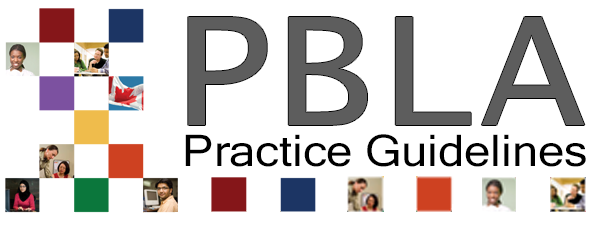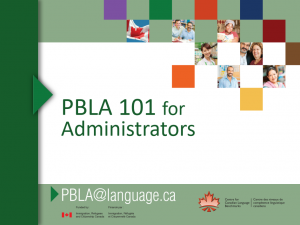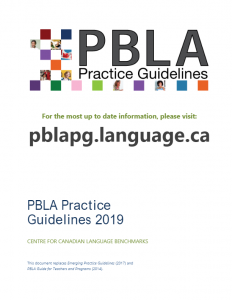PBLA Foundations
PBLA and Current Assessment Theory
PBLA and Current Assessment Theory
In the late 1990s and early 2000s, our understanding of assessment began to shift, with researchers asking fundamental questions about what assessment should accomplish and who is best placed to make assessment decisions.
Traditionally, assessment has had several purposes:
Diagnostic assessment: assessment of discrete strengths and weaknesses
Formative assessment: ongoing assessment to inform instruction and improve learner performance
Summative assessment: assessment after learning to determine what has been learned.
Formative assessment was traditionally an ongoing, frequently informal process of assessment conducted throughout the learning process and used to guide instruction and provide information to learners. Summative assessment was typically a more formal process used to determine the result of the learning at the end of a period of instruction. While the two types of assessment might differ in timing and level of formality, many have argued that the two have often served the same function, that is to determine if learning has occurred and to provide “snapshots” of where learners have “got to” (Torrance, 1993). In addition, summative assessment was typically associated with formal standardized tests, often developed externally and not necessarily related to needs and goals of learners. The teacher’s role was primarily relegated to preparing learners for the test and exam invigilation rather than meeting learners’ language learning goals.
In 1998, Paul Black and Dylan Wiliam undertook an expansive literature review that showed how formative assessment practices could be used to improve learning. The Assessment Reform Group (ARG), discussing this new understanding, commented:
Assessment which is explicitly designed to promote learning is the single most powerful tool we have for both raising standards and empowering lifelong learners (1999, p.2).
Other researchers (Hattie, 2009; Bullock, Bishop, Martin, & Reid, 2002) supported Black and Wiliam (1998), adding that the approach to assessment is a key determiner of its impact. For example, they found no evidence that increasing the amount of testing alone enhances learning. Instead, they found that the most effective assessment is planned for and goal driven, engaging both teachers and learners in reflection and dialogue.
Black and Wiliam found that an increased emphasis on what they term assessment for learning contributes to positive learner achievement in the classroom. The primary purpose of assessment for learning is to provide feedback that will promote student learning, feedback that will help learners identify where they are and what they need to do next. This type of formative assessment is often informal and is integrated into all aspects of the teaching and learning process; it happens while learning is underway. Evidence is used to diagnose learner needs, plan next steps in instruction, and provide learners with feedback they can use to improve their performance. This can be contrasted with assessment of learning, the assessment that comes after learning to determine the result of the learning.
| For a brief summary of this difference, see the Wiliam’s video Formative Assessment (Wiliam, nd). |
Black and Wiliam (1998) and others (Harlen & Gardner, 2010) went on to suggest that all assessment has the potential to be used directly to help learning. For a full discussion of these assessment possibilities, see the second section in this document, PBLA Portfolios: Key Elements. PBLA embraces the notion that all assessment should be designed to enhance learning and incorporates specific classroom strategies that have been found effective in doing so.
Based on research and work with classroom teachers, Leahy, Lyon, Thompson, and Wiliam (2005) identified five key assessment for learning (AfL) strategies. Ongoing, effective use of these strategies supports learner autonomy and has been shown to have a powerful impact on learning. All are foundational to PBLA practices.
1. Clarify learning intents and criteria for success. Language learning is enhanced when the intentions or goals of learning and the criteria for success are transparent to learners.
How is this reflected in PBLA Practice? In PBLA, teachers share learning goals for classroom modules and lessons and are clear about the expectations for the skill-using and assessment tasks2 that learners complete.
2. Incorporate classroom activities that elicit evidence of learning. Language learning is enhanced when learners engage in classroom activities that provide teachers with information they can use to adjust instruction and meet learning needs.
How is this reflected in PBLA Practice? In PBLA, learners engage in classroom activities and discussions that provide ongoing evidence of what they know, as well as gaps in their learning. This information helps teachers plan targeted activities to bridge these gaps. Teachers seek additional information through activities in which learners reflect on their learning.
3. Provide feedback that moves learners forward. Language learning is enhanced when feedback, linked to criteria, is action-oriented and addresses what the learner needs to do to improve. It is based on an understanding of the desired goal, uses evidence of where the learner is now, and provides information about how to close the gap between the two (Sadler, 1989).
How is this reflected in PBLA Practice? In PBLA, teachers are encouraged to provide feedback, based on clear criteria, that learners can act on, as well as in-class opportunities to apply the feedback.
4. Activate learners to become instructional resources for one another. Language learning is enhanced when learners engage in activities in which they can support or help one another.
How is this reflected in PBLA Practice? In PBLA, learners can provide explanations or assistance to classmates. In some cases, they can act as informed observers, giving feedback on selected aspects of performance.
5. Activate learners to become owners of their own learning. Language learning is enhanced when learners take ownership of their learning and use agreed-on criteria to carry out self-assessment and learning reflection.
How is this reflected in PBLA Practice? In PBLA, learners are involved in setting personal language learning goals and monitoring their progress toward these goals. They are clear about the expectations in real-world skill-using and assessment tasks and have opportunities to self-assess their work. Through ongoing reflections, learners identify strategies they can apply independently to improve their language ability.
The CCLB resource, Integrating CLB Assessment, Chapter 1 (CCLB, 2016) presents these strategies in detail, including suggestions for bringing these strategies to life in your classroom. Activating learners as resources for each other is discussed in Chapter 6, and action-oriented feedback in Chapter 7. Additional suggestions can be found in Embedded Formative Assessment (Wiliam, 2011).


